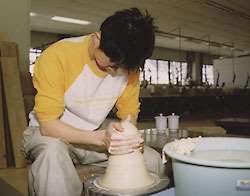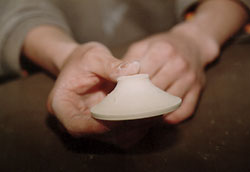Hirotsugu: The first thing you do is knead the clay. If the air bubbles in the clay aren't completely kneaded out, the piece you've made can crack or break when fired.
 The first step in training is kneading, kneading, kneading. |
Question: The rule is to knead the clay so that there's no air left in it, I've heard, but isn't this hard?
Hirotsugu: It's said to take three years to master clay kneading.
Question: I'm told that at the school, to improve in a short time, there was a period when you would just knead clay for about four hours each day.
Hirotsugu: First you knead the clay 300 times, then you turn it over and knead it another 300 times. But if you're making a vase with that clay, you would have to knead it 500 times on each side.
Can you imagine just kneading the clay for hours?
After practicing clay kneading, Hirotsugu learned how to make hama. A hama is a dish on which an article is placed for glaze firing, and the ceramist makes this as well. It has a simple shape, like a small sake cup. It is by making these that students first learn to manipulate the potter's wheel. At first, Hirotsugu found it hard to center the clay on the wheel and couldn't make perfectly circular hama. He says there were times when he made as many as 400 hama in one day before he became able to center the clay nicely.
|
|
Hirotsugu: Hama making is a very basic skill in ceramics, so I just kept on making them until I could center the clay.
Students master the basics by practicing repeatedly, and then move on to the next step. Watching Hirotsugu practice these skills taught us that each of the steps involved in making ceramics requires an astounding amount of training.
At the end of two years of intensive training in the basics, Hirotsugu produced an impressive ceramics piece for his graduation work.
 Hirotsugu shows his graduation piece. |

